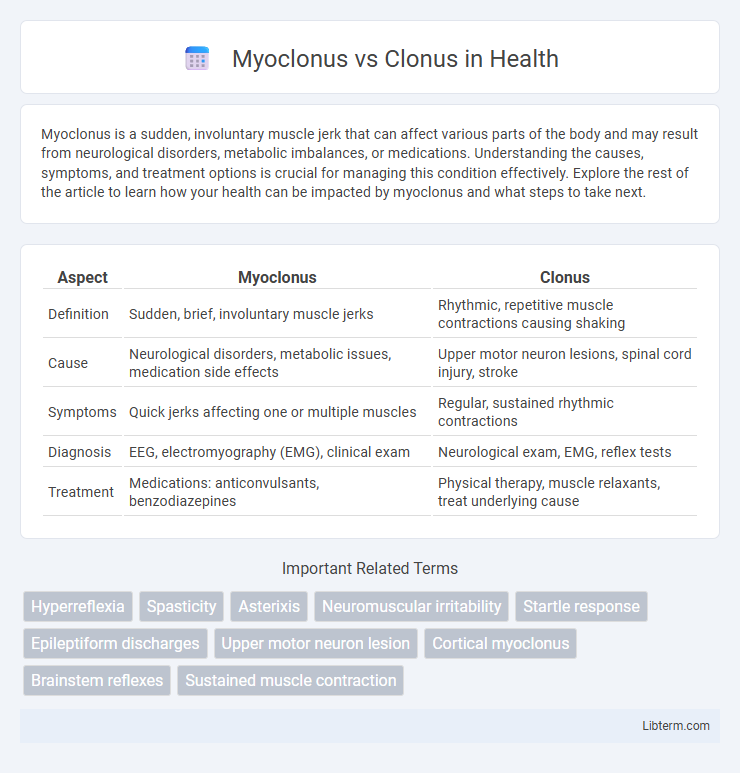Myoclonus is a sudden, involuntary muscle jerk that can affect various parts of the body and may result from neurological disorders, metabolic imbalances, or medications. Understanding the causes, symptoms, and treatment options is crucial for managing this condition effectively. Explore the rest of the article to learn how your health can be impacted by myoclonus and what steps to take next.
Table of Comparison
| Aspect | Myoclonus | Clonus |
|---|---|---|
| Definition | Sudden, brief, involuntary muscle jerks | Rhythmic, repetitive muscle contractions causing shaking |
| Cause | Neurological disorders, metabolic issues, medication side effects | Upper motor neuron lesions, spinal cord injury, stroke |
| Symptoms | Quick jerks affecting one or multiple muscles | Regular, sustained rhythmic contractions |
| Diagnosis | EEG, electromyography (EMG), clinical exam | Neurological exam, EMG, reflex tests |
| Treatment | Medications: anticonvulsants, benzodiazepines | Physical therapy, muscle relaxants, treat underlying cause |
Understanding Myoclonus: Definition and Causes
Myoclonus is characterized by sudden, involuntary muscle jerks that can result from neurological disorders such as epilepsy, metabolic imbalances, or brain injury. These rapid muscle contractions are typically brief and may affect any muscle group, distinguishing them from clonus, which involves rhythmic, repetitive muscle contractions. Understanding the underlying causes of myoclonus is critical for accurate diagnosis and effective treatment, particularly in conditions like progressive myoclonic epilepsy or drug-induced myoclonus.
Clonus Explained: What It Is and Why It Occurs
Clonus is a neurological condition characterized by rapid, involuntary muscle contractions and relaxations, often triggered by sudden stretching of a muscle. It occurs due to hyperactive reflexes linked to upper motor neuron lesions and can be a sign of underlying disorders such as multiple sclerosis, stroke, or spinal cord injury. Unlike myoclonus, which involves brief, shock-like jerks, clonus typically presents as rhythmic, sustained oscillations that help clinicians differentiate between various neuromuscular disorders.
Key Differences Between Myoclonus and Clonus
Myoclonus involves sudden, brief, involuntary muscle jerks caused by abnormal electrical activity in the brain or spinal cord, while clonus consists of rhythmic, repetitive muscle contractions typically triggered by sustained muscle stretch. Myoclonus can affect any muscle group randomly and often occurs in disorders like epilepsy or metabolic encephalopathies; clonus is commonly associated with upper motor neuron lesions, such as stroke or multiple sclerosis. The key difference lies in the pattern and cause: myoclonus is irregular and spontaneous, whereas clonus is rhythmic and induced by continuous stretch reflexes.
Neurological Mechanisms Behind Myoclonus
Myoclonus involves sudden, involuntary muscle jerks caused by abnormal electrical discharges in the brain, spinal cord, or peripheral nerves, often linked to dysfunctional cortical or subcortical neurons. Clonus features rhythmic muscle contractions resulting from hyperactive stretch reflexes due to upper motor neuron lesions affecting descending inhibitory pathways. The neurological mechanism of myoclonus centers on a disrupted balance between excitatory and inhibitory signals within the central nervous system, leading to erratic activation of motor neurons.
Pathophysiology of Clonus in Neurological Disorders
Clonus results from hyperexcitability of the stretch reflex due to upper motor neuron lesions disrupting descending inhibitory pathways, leading to repetitive, involuntary muscle contractions. This oscillatory neuromuscular activity is commonly observed in conditions such as multiple sclerosis, stroke, and spinal cord injury. Understanding the pathophysiology of clonus aids in differentiating it from myoclonus, which originates from cortical or subcortical discharges rather than reflex arcs.
Signs and Symptoms of Myoclonus vs Clonus
Myoclonus presents as sudden, brief, involuntary muscle jerks often affecting a single muscle or group, typically without rhythmic pattern, and can occur at rest or during movement. Clonus is characterized by rhythmic, repetitive muscle contractions and relaxations, commonly seen in the ankle or wrist, resulting from hyperactive stretch reflexes linked to upper motor neuron lesions. While myoclonus manifests as irregular twitches that may disrupt voluntary activity, clonus features sustained oscillations indicating neurological damage.
Diagnostic Approaches for Myoclonus and Clonus
Diagnostic approaches for myoclonus emphasize detailed clinical assessment combined with electrophysiological studies such as electromyography (EMG) and electroencephalography (EEG) to identify the origin and pattern of sudden, brief muscle jerks. In contrast, clonus diagnosis primarily relies on physical examination highlighting rhythmic, sustained muscle contractions triggered by sudden muscle stretch, often confirmed through neurological testing to assess upper motor neuron lesions. Advanced imaging techniques like MRI and sometimes metabolic or genetic testing support differential diagnosis between these involuntary movement disorders.
Treatment Strategies: Managing Myoclonus and Clonus
Treatment strategies for myoclonus typically involve anticonvulsants such as clonazepam, valproic acid, and levetiracetam, which help reduce involuntary muscle jerks by modulating neurotransmitter activity. Clonus management often includes muscle relaxants like baclofen or tizanidine to decrease muscle spasticity and reflex hyperactivity that cause repetitive contractions. Physical therapy and targeted interventions like botulinum toxin injections can be effective adjuncts in both myoclonus and clonus, improving functional mobility and quality of life.
Prognosis and Quality of Life Considerations
Myoclonus prognosis varies widely depending on underlying causes, with some forms being benign and others progressive, impacting quality of life through sudden, involuntary muscle jerks that disrupt daily activities. Clonus often indicates upper motor neuron lesions and can be managed with medications and physical therapy, though persistent clonus may lead to stiffness and impaired mobility, affecting long-term functionality. Both conditions require tailored treatment plans to optimize neurological function and improve patients' overall quality of life by minimizing symptom severity and associated disabilities.
Frequently Asked Questions About Myoclonus and Clonus
Myoclonus and clonus are involuntary muscle contractions with distinct characteristics; myoclonus involves sudden, brief jerks of a muscle or group of muscles, while clonus consists of rhythmic, repetitive contractions typically caused by neurological conditions. Frequently asked questions about myoclonus focus on its causes, such as epilepsy, metabolic disorders, or medications, and treatment options including medication and lifestyle changes. Common inquiries about clonus address its association with upper motor neuron lesions, symptoms like sustained rhythmic muscle spasms, and approaches for managing underlying neurological disorders.
Myoclonus Infographic

 libterm.com
libterm.com